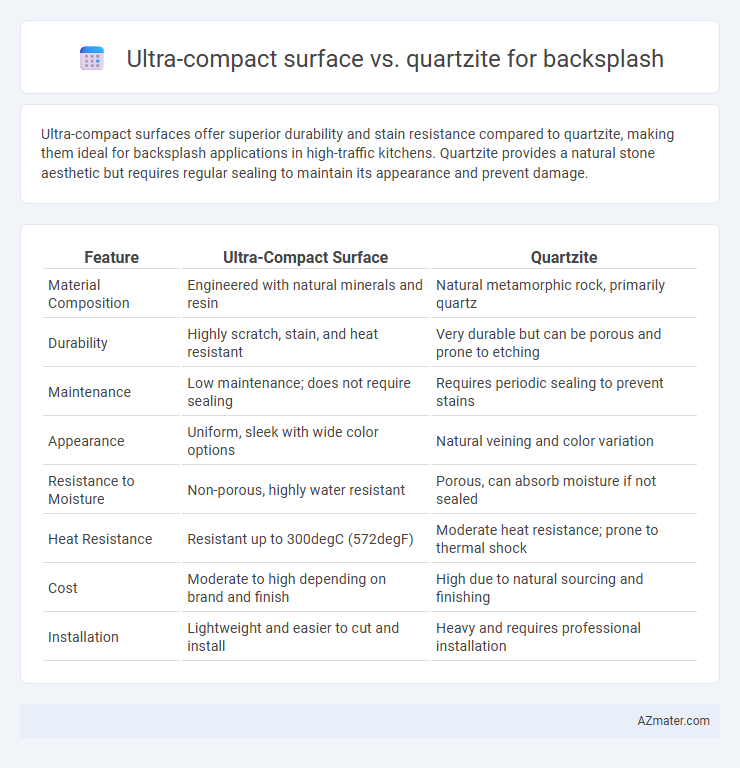Ultra-compact surfaces offer superior durability and stain resistance compared to quartzite, making them ideal for backsplash applications in high-traffic kitchens. Quartzite provides a natural stone aesthetic but requires regular sealing to maintain its appearance and prevent damage.
Table of Comparison
| Feature | Ultra-Compact Surface | Quartzite |
|---|---|---|
| Material Composition | Engineered with natural minerals and resin | Natural metamorphic rock, primarily quartz |
| Durability | Highly scratch, stain, and heat resistant | Very durable but can be porous and prone to etching |
| Maintenance | Low maintenance; does not require sealing | Requires periodic sealing to prevent stains |
| Appearance | Uniform, sleek with wide color options | Natural veining and color variation |
| Resistance to Moisture | Non-porous, highly water resistant | Porous, can absorb moisture if not sealed |
| Heat Resistance | Resistant up to 300degC (572degF) | Moderate heat resistance; prone to thermal shock |
| Cost | Moderate to high depending on brand and finish | High due to natural sourcing and finishing |
| Installation | Lightweight and easier to cut and install | Heavy and requires professional installation |
Introduction to Ultra-Compact Surface and Quartzite
Ultra-compact surfaces are engineered materials composed of natural minerals, offering high durability, resistance to scratches, stains, and heat, making them ideal for kitchen backsplashes. Quartzite is a natural metamorphic rock known for its strength, heat resistance, and unique veining, providing a luxurious and natural aesthetic. Both materials deliver long-lasting beauty and functionality, but ultra-compact surfaces offer greater consistency in color and texture compared to the natural variations found in quartzite.
Material Composition and Characteristics
Ultra-compact surfaces are crafted from a blend of natural minerals, including quartz, porcelain, and glass, fired at extremely high temperatures to create a dense, non-porous material resistant to stains, heat, and scratches. Quartzite, a natural metamorphic stone formed from sandstone, features a crystalline structure with high hardness and durability but requires sealing to prevent staining and etching from acidic substances. Both materials offer unique aesthetic qualities for backsplashes; ultra-compact surfaces provide consistent patterns and superior resistance, while quartzite delivers natural veining and texture with maintenance considerations.
Visual Appeal and Style Options
Ultra-compact surfaces offer a sleek, modern visual appeal with a wide range of vibrant colors and patterns, making them highly customizable for unique backsplash designs. Quartzite provides a natural, elegant look with its intricate veining and soft color variations, ideal for a timeless and sophisticated kitchen style. Both materials provide durable, low-maintenance options, but ultra-compact surfaces excel in versatility and contemporary aesthetics.
Durability and Resistance to Damage
Ultra-compact surfaces offer exceptional durability and resistance to damage, featuring high density and low porosity that make them impervious to scratches, stains, and heat, ideal for kitchen backsplashes. Quartzite, a natural stone, provides significant toughness and heat resistance but can be more prone to chipping and requires periodic sealing to maintain its surface integrity. Comparing both, ultra-compact surfaces deliver superior long-term durability with minimal maintenance, while quartzite offers natural beauty with moderate upkeep and good, though slightly less robust, damage resistance.
Maintenance and Cleaning Requirements
Ultra-compact surfaces offer superior resistance to stains, scratches, and heat, making them exceptionally easy to maintain and clean with just mild soap and water. Quartzite, while durable, requires periodic sealing to prevent staining and can be more susceptible to acidic spills, necessitating careful cleaning with pH-neutral products. Choosing ultra-compact materials for backsplashes reduces long-term maintenance efforts and enhances durability in high-traffic kitchen areas.
Heat and Stain Resistance Comparison
Ultra-compact surfaces exhibit superior heat resistance, withstanding temperatures up to 450degC without damage, making them ideal for kitchen backsplashes exposed to hot pots and pans. Quartzite, a natural stone, offers good heat resistance but can suffer from thermal shock and discoloration under direct high heat due to its mineral composition. Both materials possess high stain resistance, but ultra-compact surfaces are non-porous and more impervious to staining chemicals compared to quartzite, which requires periodic sealing to maintain its stain-resistant properties.
Installation Process and Considerations
Ultra-compact surfaces offer a faster and cleaner installation process for backsplashes due to their lightweight nature and pre-polished finish, reducing labor costs and time. Quartzite requires careful handling during installation because of its natural stone properties, including potential fragility and the need for professional sealing to prevent staining. When considering a backsplash, ultra-compact materials provide easier maintenance and a streamlined installation, while quartzite demands skilled expertise and additional preparation to ensure durability and aesthetic appeal.
Cost and Value Analysis
Ultra-compact surfaces typically cost between $50 to $120 per square foot, offering superior durability and stain resistance compared to quartzite, which ranges from $40 to $100 per square foot. Quartzite provides a natural stone aesthetic and can increase home value, but it requires more maintenance and sealing to prevent staining and damage. Investing in ultra-compact materials ensures long-term savings due to lower upkeep costs and enhanced lifespan, presenting a better overall value despite the slightly higher initial expense.
Eco-Friendliness and Sustainability
Ultra-compact surfaces offer superior eco-friendliness due to their low porosity, minimal water absorption, and use of recycled materials, making them highly sustainable for backsplashes. Quartzite, a natural stone, is durable and long-lasting but requires quarrying processes that have a higher environmental impact compared to engineered ultra-compact surfaces. Selecting ultra-compact materials supports reduced waste and energy-efficient production, aligning with sustainable building practices.
Best Applications and User Recommendations
Ultra-compact surfaces offer superior durability and resistance to heat, stains, and scratches, making them ideal for high-use kitchen backsplashes, especially in modern or minimalist designs. Quartzite, with its natural stone texture and heat resistance, suits users seeking a more organic aesthetic and is recommended for moderate-use areas where natural variations enhance visual appeal. Homeowners prioritizing low maintenance and maximum durability often prefer ultra-compact materials, while quartzite appeals to those valuing natural beauty and unique stone patterns.

Infographic: Ultra-compact surface vs Quartzite for Backsplash
 azmater.com
azmater.com